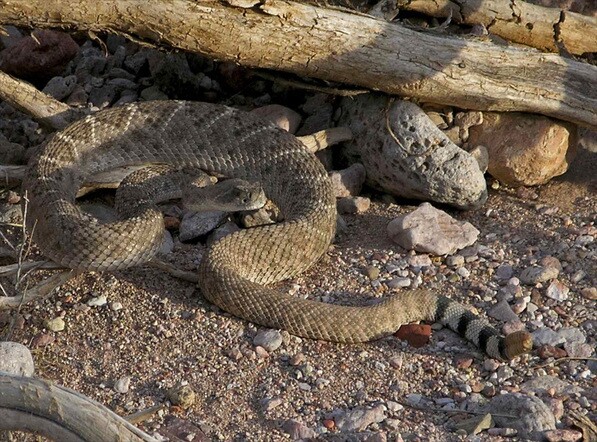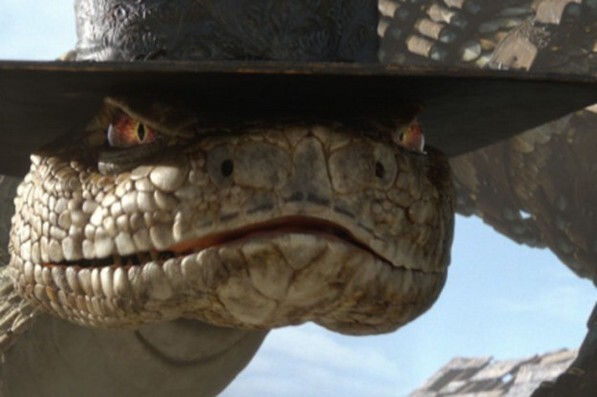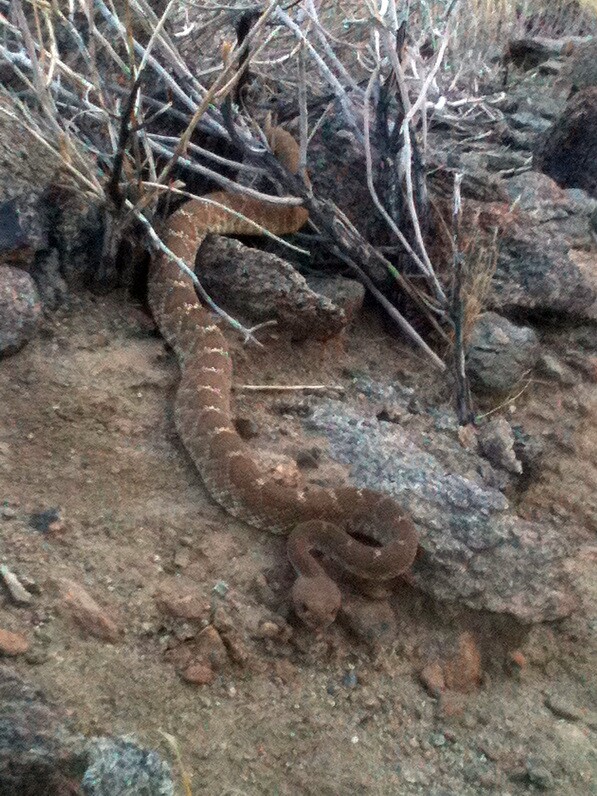Hollywood Gives Rattlers A Bad Rap, Again

One of the best things about political life these days is that people aren't afraid to call out a bigoted stereotype in the media when they see one. Today I feel compelled to do my part. I know I'm hopelessly behind the times; The film came out almost a year ago. But I finally got around to watching "Rango," and though I liked it, I have to say the movie helps to perpetuate some baseless, derogatory stereotypes that are utterly unfair to rattlesnakes.
And as snake season is starting in the desert, those stereotypes are worth addressing.
In the movie, rattlesnakes are portrayed as cruel, sadistic, and malevolent. Or at least the one rattlesnake that appears in *Rango* possesses those qualities in spades. He's got demonic-seeming eyes that glow with avarice. He's got a Gatling gun instead of a rattle. He's got a pencil-thin villain mustache. I recognize that most people know real snakes mostly don't have the last two things. And Rattlesnake Jake isn't even the biggest badguy in the movie. But he's definitely the scariest. His general meanness and the near-overpowering menace in his mere presence are there for a reason: people are afraid of rattlers, and the writers capitalized on that fear to get a rise out of us.

Prejudice against rattlers wasn't the only problem I had with *Rango.* For one thing, the setting's referred to as "the Mojave Desert," and yet there are saguaros growing there with armadillos wandering beneath them. Saguaros grow in the Sonoran Desert, not the Mojave, and armadillos aren't found in either of those places.
That kind of geographical goof tends to bother me more than other minor inaccuracies, say for instance desert animals walking on their hind legs, speaking English and wearing clothes. And Rango is far from the first movie to get its organisms in the wrong place. Cataloguing that kind of goof is a favorite pastime among naturalists.
But the snake thing rubbed me the wrong way. Though using a rattlesnake as a villain was almost certainly just intended as a riff on existing public fear, encouraging that fear can have dire consequences.
The thing is, rattlesnakes are timid, generally gentle animals. Given any choice at all, they will always do what they can to avoid biting you. If you've hiked more than 20 miles in California in your life, you have almost certainly come within five feet of a rattlesnake without knowing it. I came upon one a month ago in the hills above Palm Springs, and I shot some less-than-exciting video:
That's video shot with a phone, which means I was standing six to eight feet away from the snake as it crossed the trail. I'd gotten well within striking distance, two feet or less, before I saw it. It rattled quietly. There was no way I could pass it without risking a bite, so I backed off a few feet and sat down on a nearby rock. The thrilling climax to the encounter was as you see it in the video above: the snake eventually decided to saunter away in no particular hurry. It was a polite, indeed lovely encounter.
That was a red diamond rattlesnake, Crotalus ruber. It's one of the more even-tempered snakes in California; I might well have been able to walk past it with my bare ankles without having my day ruined. Which is not a recommendation. Still, it was placid enough that it posed for a reasonably pretty picture, all the while tasting the air with its tongue to figure out what I was:

There are a few of California's several species of rattlesnakes, especially the western diamond-backed and Mojave green rattlers, that are much less likely to tolerate such close intrusion into their personal spaces. Both of those species are less agreeable than the red diamond. If it had been a Mojave green rather than a red diamond, *I'd* have likely been the one to lose the standoff and go around.
Even in encounters with the less-friendly species of rattlesnake, however, there are three basic scenarios in which you're most likely to be bitten. They are, in order of increasing prevalence:
- You are off-trail or climbing and paying less attention to where you stick your hands and feet than is prudent
- You are a small child, an untrained dog, or any other person with a diminished capacity for calm, rational judgment
- You are totally asking for it and should know better.
That last category would seem to cover the majority of rattlesnake bites. One Arizona study found that:
- Men account for 80 percent of rattlesnake bites
- The average age of those men is 24
- Four fifths of rattler bites are on the victim's hand or fingers
- Three fifths of bite victims admitted to intentionally handling the snake
- A quarter of all bite victims were apparently intoxicated at the time of the incident.
And yet the snakes get the blame. If you take reasonable precautions, and if you stay alert and give any snakes you find a wide berth, and if you start dialing 911 as soon as any of your hiking buddies says "hey, hold my beer," you eliminate the risk of snakebite almost entirely.
Of course if you do get bitten time is of the essence, it's important to know how to respond, and I've put together a few important dos and don'ts in this separate post.
My point, though, is that while rattlesnakes are able to defend themselves rather effectively, they do not go out of their way to harass or attack people. A large number of snakebites stem from the victim's overreaction to the perceived threat the snake poses. Naturalists, park rangers, animal control people, and public safety officers have been working to educate people on how to enjoy rattlesnake encounters safely for decades. Media accounts of "aggressive" and "hostile" snakes, even fictional accounts, pander to public fear of the animals, and undo that public education.
The result isn't just that people overreact and get bitten, or that perfectly placid rattlers with the misfortune to be spotted by those people suffer. There are long-term safety implications that affect even those of us who know how to comport ourselves in snake country.
In Northern California, biologists have reported for some time that rattlers are less likely to rattle before striking. The theory is that rattlers offer polite warning when people stray too close, those people panic and bludgeon or shoot the snake, and meanwhile rattlers that are less rattly go unnoticed and reproduce afterwards. Eventually, you get a population of snakes that are less likely to sound off before biting.
That's a lot of weight to lay on what is essentially a cartoon snake, I admit. But that was a choice the writers made, much like their choice to put armadillos and saguaros in the Mojave: unsupported by fact, essentially a lazy writing shortcut. There simply was no need to augment public fears by making the rattlesnake in Rango a bad guy when there were other villainous options available.
I mean, come on. They had desert water developers right there in the movie already.
Chris Clarke is an environmental writer of two decades standing. Author of Walking With Zeke, he writes from Palm Springs regularly at his acclaimed blog Coyote Crossing and comments on desert issues on KCET weekly. Read his recent posts here.


